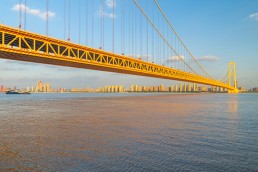Union Bridge 1820
Union Bridge 1820
The Bridge
The Union Chain Bridge became the UK’s first vehicular suspension bridge when it connected England and Scotland with a crossing of the River Tweed in 1820. The Royal Navy officer, Captain Samuel Brown, had been developing wrought iron chains and realised their use on bridge construction.
The bridge has undergone development and renovation over the past two centuries. Cables were added in 1902 and the deck has been renewed. The bridge is currently undergoing major restoration work.
When Bill Brown delivered his ‘History of Suspension Bridge Design’ presentation to engineering conferences and audiences throughout the world he would begin with a feature on the Union Bridge.
Union Bridge
Chain suspension bridge linking England and Scotland
Key Facts
Wrought iron chains used for bridge suspension
Much cheaper and faster to build than a masonry bridge
Location
Horncliffe in England to Fishwick in Scotland
Across the River Tweed
Designer
Captain Samuel Brown
Description
Chain suspension bridge
110m main span
137m total length
Main contractors
Captain Samuel Brown (chains and deck)
John Rennie (masonry towers)
Construction
Began in August 1819
Opened July 1820































































